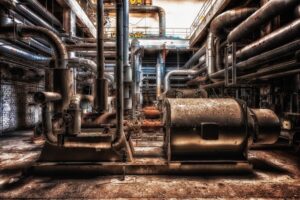Table of Contents
- Introduction to Bearings
- Types of Bearings and Their Applications
- Innovation in Bearing Technology
- Importance in Industrial Operations
- Maintaining and Extending Lifespan
- Challenges in Bearing Use
- Future Trends
Introduction to Bearings
Bearings are fundamental components embedded within countless machinery, ensuring the smooth operation of moving parts. Their primary role is reducing friction and enhancing performance efficiency and machinery longevity. By minimizing resistance, bearings allow rotating or moving parts to glide effortlessly, transforming energy into movement with minimal waste. In the ever-evolving landscapes of technology and industry, bearings have stood as silent yet essential pillars of progress. From the intricate mechanisms of a wristwatch to the gargantuan rotators in wind turbines, bearings enhance daily functions, providing reliability and efficiency where it is most needed. As machinery grows more complex, the demand for superior bearing quality increases exponentially. Whether a small gadget or a massive industrial machine, bearings are the critical components, ensuring everything runs smoothly and effectively.
Types of Bearings and Their Applications
The world of bearings is as diverse as the machinery that depends on them. Various types of bearings have been perfected to meet specific requirements in distinct applications. Among the most common, ball bearings are prized for their ability to operate at high speeds with minimal friction. They are typically found in applications where low friction and high precision are paramount, such as in skateboards, computer fans, and electric motors.
With their unique cylindrical designs, roller bearings handle heavier loads than ball bearings. These bearings are integral to industries that demand robustness, including the construction and automotive sectors, where they support significant weight and strain. Meanwhile, thrust bearings are engineered to withstand axial loads, making them vital to support high-speed rotations and directional shifts in the automotive industry. With specialized designs for demanding environments, these bearings illustrate the adaptability of bearing technology across various mechanical landscapes, including more niche applications such as aerospace and defense.
It’s important to note that proper maintenance, including regular lubrication and inspection, is crucial for the optimal performance and longevity of all types of bearings, from small bearings used in everyday appliances to larger bearings used in industrial machinery and even within the construction of high-pressure hoses.
Innovation in Bearing Technology
Technological advancements have revolutionized bearing design and materials, steering the industry toward more efficient and durable solutions. Today’s bearings often feature innovative materials, such as ceramic and advanced polymers, which offer superior wear resistance and reduced mass compared to traditional steel bearings. These enhancements reduce maintenance needs and extend the lifespan of the machinery.
Research in engineering fields highlights that contemporary bearings can operate under extreme conditions, such as high temperatures and severe loads, without compromising performance. These innovations facilitate the development of high-performance applications, from renewable energy systems to the electric vehicle market expansion. Bearings utilizing smart technology and integrating sensors for real-time condition monitoring exemplify the future of predictive maintenance strategies, reducing downtime and optimizing machine performance.
Importance in Industrial Operations
Industries around the world heavily rely on bearings to conduct seamless operations. By minimizing friction, bearings significantly contribute to conserving energy, ensuring smoother mechanical operations, and effectively reducing costs. Their presence in machinery enables the consistent performance of engines, gearboxes, and conveyor belts. Bearings, positioned between stationary and moving parts, facilitate smooth transitions, enabling machinery to achieve the desired operational efficiencies.
In manufacturing setups, where constant operation is paramount, bearings help minimize downtime attributed to machine failures or maintenance shutdowns. The strategic implementation of high-quality bearings ensures reliability, translating directly to enhanced productivity and profit margins. The choice of superior bearings reflects industries’ commitment to maintaining high workmanship and operational safety standards.
Maintaining and Extending Lifespan
Maintenance is crucial in securing bearings’ performance and efficiency. This involves regular inspections for wear and tear, which can identify potential issues before they evolve into more significant problems. Appropriate lubrication is essential, reducing friction and preventing overheating, thus extending bearing life.
Moreover, protecting bearings from external contaminants like dust and moisture is critical, as these can accelerate wear. Failure to perform regular maintenance can lead to costly downtime and unexpected repairs, affecting productivity. By integrating meticulous maintenance schedules, businesses can maximize the effectiveness and durability of their machinery, safeguarding investments in high-quality bearing technology.
Challenges in Bearing Use
Despite their numerous advantages, bearings face challenges that require careful consideration and planning. Wear and tear, an inevitable result of continued use under load necessitates a proactive approach to maintenance and replacement to maintain functionality. Ensuring proper installation is crucial, as misalignments can lead to premature failures and operational inefficiencies.
Furthermore, adapting to diverse operational conditions can be challenging. Bearings must withstand varying loads, speeds, and environmental factors, complicating their design and material choices. As discussed in a recent Newsweek article, manufacturers continuously explore innovative solutions to overcome these challenges, utilizing advanced research to enhance the resilience and adaptability of bearings in today’s mechanized world.
Future Trends
The bearing industry is on the cusp of ush innovation and transformation, with emerging trends reflecting the broader technological advancements in the industrial sector. Smart bearings, equipped with sensors and IoT capabilities, are leading the charge toward predictive maintenance, where real-time analytics can detect early wear signs and provide alerts before critical failures occur. This innovation promises to transform maintenance protocols in various sectors.
Moreover, sustainable and eco-friendly bearings are gaining popularity as industries strive to meet environmental regulations and pursue greener practices. These bearings are engineered to offer efficient performance with reduced environmental impact, aligning with global sustainability goals. As technology advances, bearings are poised to become even more integral to machinery, enhancing operational efficiency, reducing costs, and supporting worldwide sustainability efforts.








